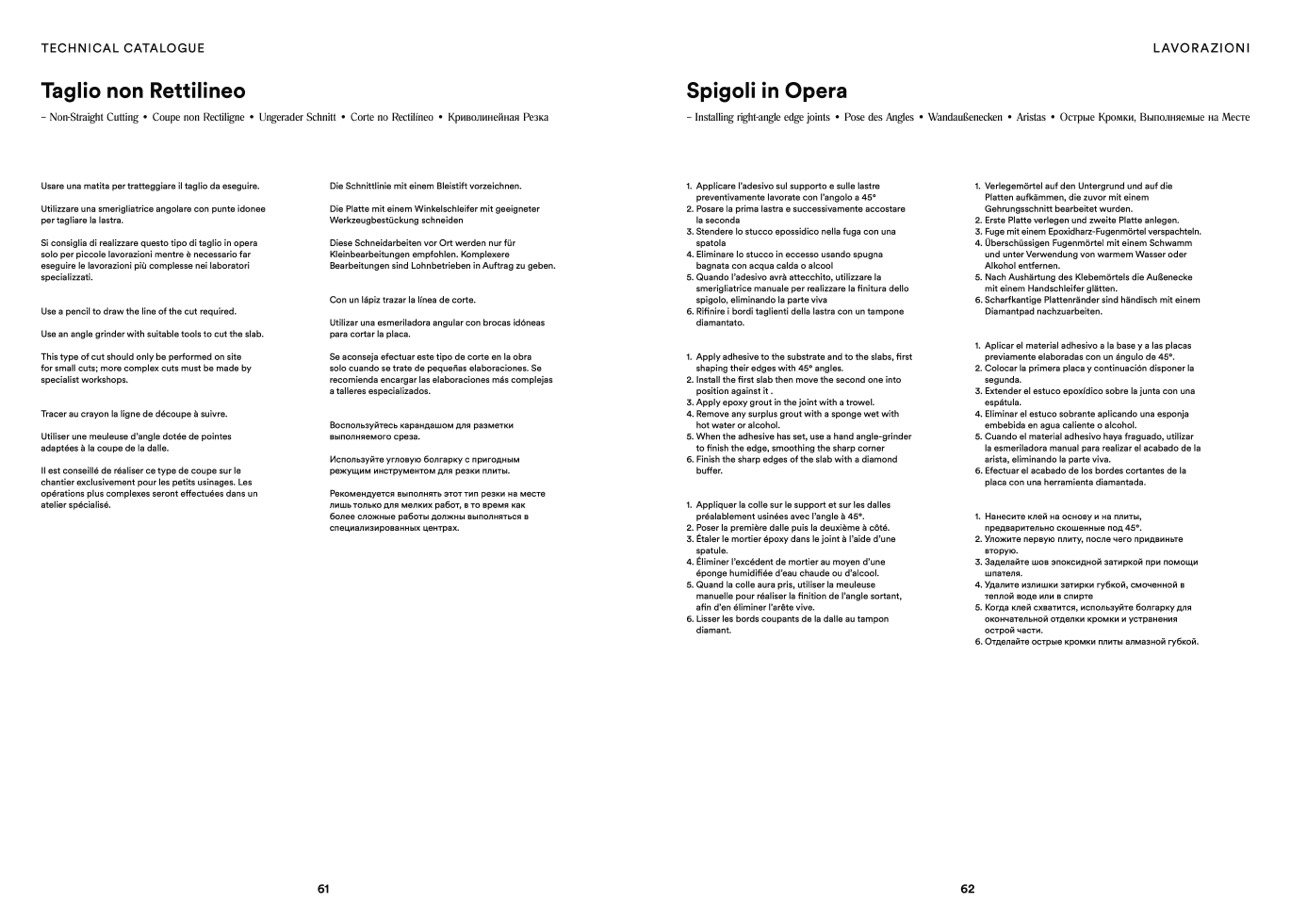
TECHNICAL CATALOGUE
LAVORAZIONI
Taglio non Rettilineo
– Non-Straight Cutting • Coupe non Rectiligne • Ungerader Schnitt • Corte no Rectilíneo • Криволинейная Резка
Spigoli in Opera
– Installing right-angle edge joints • Pose des Angles • Wandaußenecken • Aristas • Острые Кромки, Выполняемые на Месте
Usare una matita per tratteggiare il taglio da eseguire.
Utilizzare una smerigliatrice angolare con punte idonee
per tagliare la lastra.
Si consiglia di realizzare questo tipo di taglio in opera
solo per piccole lavorazioni mentre è necessario far
eseguire le lavorazioni più complesse nei laboratori
specializzati.
Use a pencil to draw the line of the cut required.
Use an angle grinder with suitable tools to cut the slab.
This type of cut should only be performed on site
for small cuts; more complex cuts must be made by
specialist workshops.
Tracer au crayon la ligne de découpe à suivre.
Utiliser une meuleuse d’angle dotée de pointes
adaptées à la coupe de la dalle.
Il est conseillé de réaliser ce type de coupe sur le
chantier exclusivement pour les petits usinages. Les
opérations plus complexes seront effectuées dans un
atelier spécialisé.
Die Schnittlinie mit einem Bleistift vorzeichnen.
Die Platte mit einem Winkelschleifer mit geeigneter
Werkzeugbestückung schneiden
Diese Schneidarbeiten vor Ort werden nur für
Kleinbearbeitungen empfohlen. Komplexere
Bearbeitungen sind Lohnbetrieben in Auftrag zu geben.
Con un lápiz trazar la línea de corte.
Utilizar una esmeriladora angular con brocas idóneas
para cortar la placa.
Se aconseja efectuar este tipo de corte en la obra
solo cuando se trate de pequeñas elaboraciones. Se
recomienda encargar las elaboraciones más complejas
a talleres especializados.
Воспользуйтесь карандашом для разметки
выполняемого среза.
Используйте угловую болгарку с пригодным
режущим инструментом для резки плиты.
Рекомендуется выполнять этот тип резки на месте
лишь только для мелких работ, в то время как
более сложные работы должны выполняться в
специализированных центрах.
1.
2.
3.
4.
5.
6.
1.
2.
3.
4.
5.
6.
1.
2.
3.
4.
5.
6.
Applicare l’adesivo sul supporto e sulle lastre
preventivamente lavorate con l’angolo a 45°
Posare la prima lastra e successivamente accostare
la seconda
Stendere lo stucco epossidico nella fuga con una
spatola
Eliminare lo stucco in eccesso usando spugna
bagnata con acqua calda o alcool
Quando l’adesivo avrà attecchito, utilizzare la
smerigliatrice manuale per realizzare la finitura dello
spigolo, eliminando la parte viva
Rifinire i bordi taglienti della lastra con un tampone
diamantato.
Apply adhesive to the substrate and to the slabs, first
shaping their edges with 45° angles.
Install the first slab then move the second one into
position against it .
Apply epoxy grout in the joint with a trowel.
Remove any surplus grout with a sponge wet with
hot water or alcohol.
When the adhesive has set, use a hand angle-grinder
to finish the edge, smoothing the sharp corner
Finish the sharp edges of the slab with a diamond
buffer.
Appliquer la colle sur le support et sur les dalles
préalablement usinées avec l’angle à 45°.
Poser la première dalle puis la deuxième à côté.
Étaler le mortier époxy dans le joint à l’aide d’une
spatule.
Éliminer l’excédent de mortier au moyen d’une
éponge humidifiée d’eau chaude ou d’alcool.
Quand la colle aura pris, utiliser la meuleuse
manuelle pour réaliser la finition de l’angle sortant,
afin d’en éliminer l’arête vive.
Lisser les bords coupants de la dalle au tampon
diamant.
1. Verlegemörtel auf den Untergrund und auf die
Platten aufkämmen, die zuvor mit einem
Gehrungsschnitt bearbeitet wurden.
2. Erste Platte verlegen und zweite Platte anlegen.
3. Fuge mit einem Epoxidharz-Fugenmörtel verspachteln.
4. Überschüssigen Fugenmörtel mit einem Schwamm
und unter Verwendung von warmem Wasser oder
Alkohol entfernen.
5. Nach Aushärtung des Klebemörtels die Außenecke
mit einem Handschleifer glätten.
6. Scharfkantige Plattenränder sind händisch mit einem
Diamantpad nachzuarbeiten.
1. Aplicar el material adhesivo a la base y a las placas
previamente elaboradas con un ángulo de 45°.
2. Colocar la primera placa y continuación disponer la
segunda.
3. Extender el estuco epoxídico sobre la junta con una
espátula.
4. Eliminar el estuco sobrante aplicando una esponja
embebida en agua caliente o alcohol.
5. Cuando el material adhesivo haya fraguado, utilizar
la esmeriladora manual para realizar el acabado de la
arista, eliminando la parte viva.
6. Efectuar el acabado de los bordes cortantes de la
placa con una herramienta diamantada.
1. Нанесите клей на основу и на плиты,
предварительно скошенные под 45°.
2. Уложите первую плиту, после чего придвиньте
вторую.
3. Заделайте шов эпоксидной затиркой при помощи
шпателя.
4. Удалите излишки затирки губкой, смоченной в
теплой воде или в спирте
5. Когда клей схватится, используйте болгарку для
окончательной отделки кромки и устранения
острой части.
6. Отделайте острые кромки плиты алмазной губкой.
61
62

